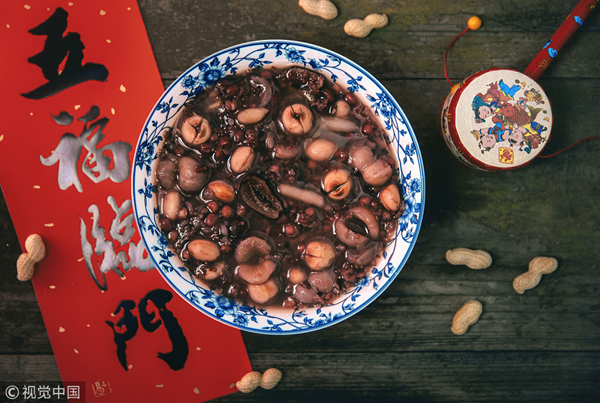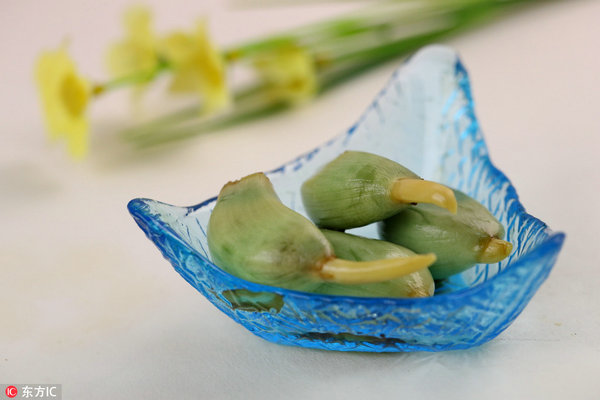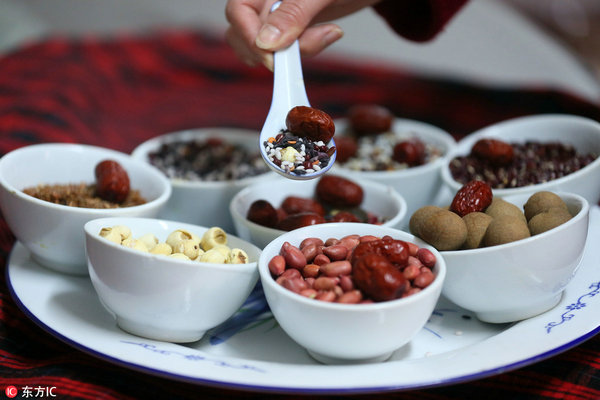过了腊八就是年 Laba porridge sweetens prelude of Chinese Lunar New Year
chinadaily.com.cn 2024-01-18 20:18


Chinese people start their preparations for the Spring Festival (Chinese Lunar New Year) more than 20 days ahead (中国人会提前20多天就开始为春节做准备, zhōng guó rén huì tí qián 20 duō tiān jiù kāi shǐ wèi chūn jié zuò zhǔn bèi). The 12th lunar month in Chinese is called la yue, so the eighth day of this lunar month is la yue chu ba, or laba (在中国,农历十二月被称为腊月,腊月的第八天是腊月初八,也叫“腊八”zài zhōng guó, nóng lì shí èr yuè bèi chēng wéi là yuè, là yuè de dì bā tiān shì là yuè chū bā, yě jiào“ là bā”). The day is also known as the Laba Rice Porridge Festival (腊八节, là bā jié). The Laba this year falls on Jan 18.

Three major customs on Laba are ancestor worship, eating Laba rice porridge and making Laba garlic (“腊八”的三大习俗是祭祖、吃腊八粥和做腊八蒜 “là bā”de sān dà xí sú shì jì zǔ、chī là bā zhōu hé zuò là bā suàn).
Ancestor worship (祭祖, jì zǔ): At the end of the year, working people get more free time to prepare for the sacrifice to the ancestors. The reason the 12th lunar month is called La Yue has a lot to do with the custom of sacrifice (祭祀, jì sì).
First, the worship of ancestors, called "la" (腊 là) in Chinese, and the sacrifice for the gods (祭神, jì shén), called "la" (蜡 là), both frequently took place in the 12th month, which led to the traditional name of the month: la yue. Second, winter is the slack season for farmers so they have time to find things to burn in the sacrifice. The radical of "腊" represents the sacrifice of meat to one's ancestors ("月" symbolizes meat).
Laba rice porridge (腊八粥, là bā zhōu): There are several legends (传说, chuán shuō) about the origin of porridge eating on Laba: Some claim it is of Buddhist (佛教, fó jiào) origin; some say the porridge, made of red beans, can exorcize evil from children (红豆熬成粥为孩子祛疫消灾, hóng dòu áo chéng zhōu wèi hái zi qū yì xiāo zāi). Others say the porridge is in memory of a poor couple.
The custom of porridge eating has been well known throughout history, from the royal court to common people.
The most "authentic" porridge was made in northern China, especially Beiping, today's Beijing.

The main ingredients of the Laba porridge are rice and sticky rice (大米和糯米, dà mǐ hé nuò mǐ); people also add sugar, red dates, lotus seeds, walnuts, chestnuts, almonds, longans, hazelnuts, raisins, red beans, peanuts, water caltrops, roseleaf and other various materials (糖、红枣、莲子、核桃、栗子、杏仁、桂圆、榛子、葡萄干、红豆、花生、菱角、玫瑰花瓣等 táng、hóng zǎo、lián zǐ、hé tao、lì zi、xìng rén、guì yuán、zhēn zi、pú táo gān、hóng dòu、huā shēng、líng jiǎo、méi guī huā bàn děng)to make the porridge special.
来源:中国日报网
编辑:万月英

















 英语点津微信
英语点津微信 双语小程序
双语小程序